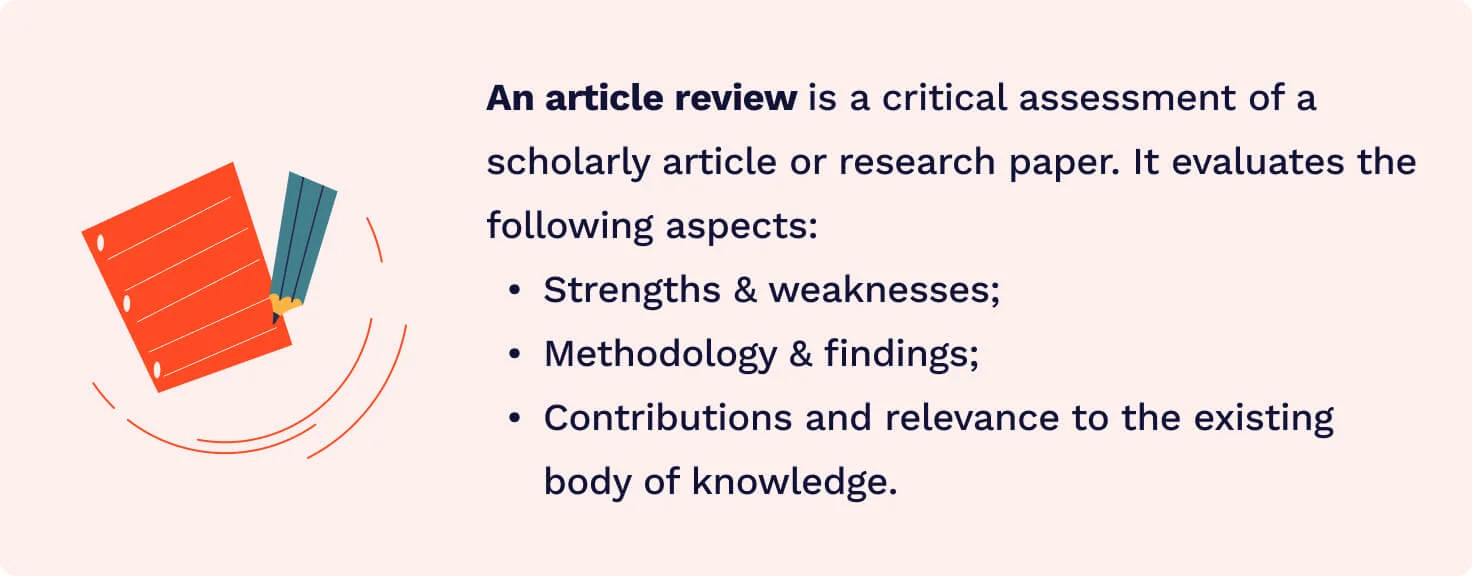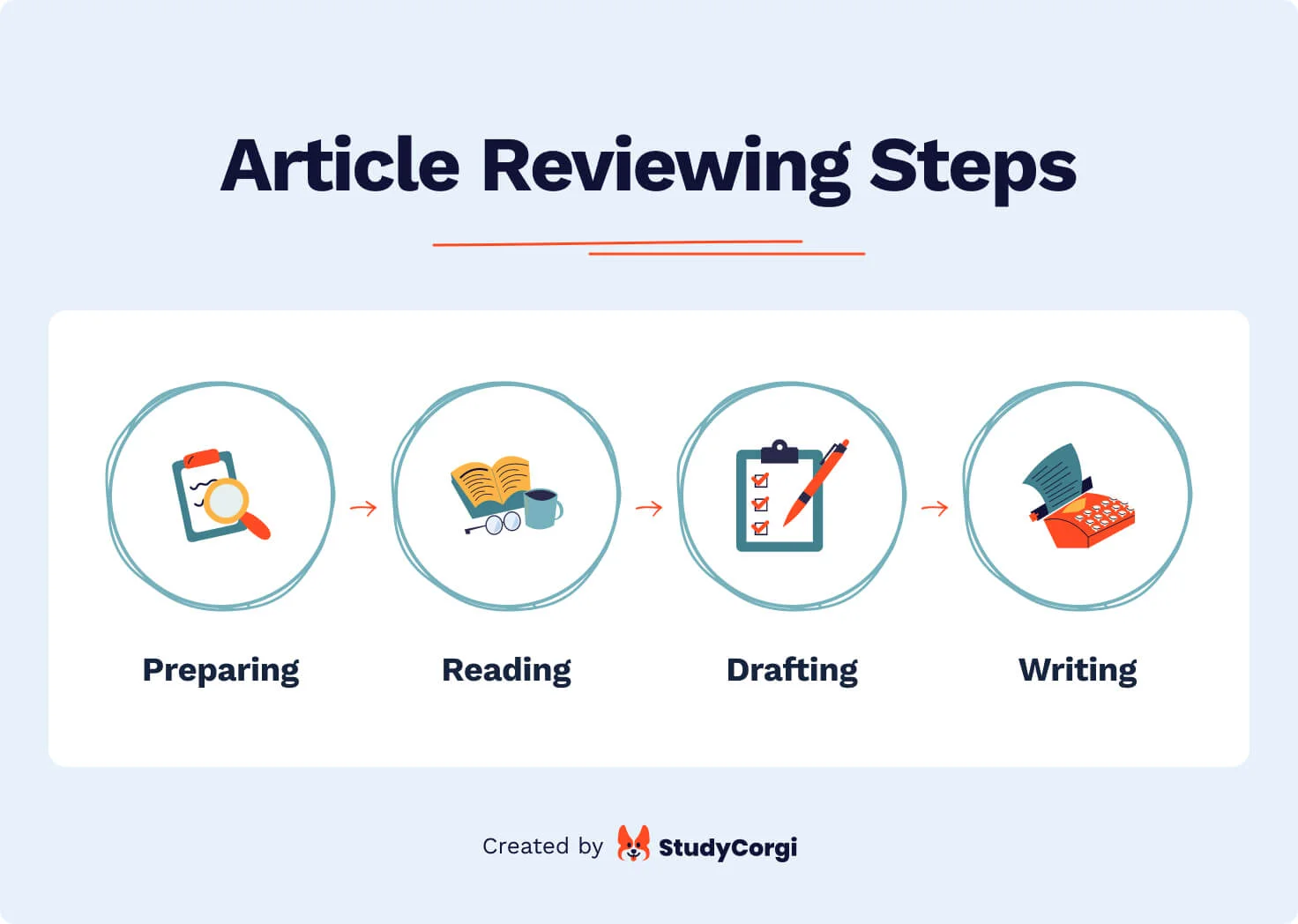🎤 What Is the Article Review Generator?
Our online article review generator is an excellent solution for crafting comprehensive reviews. It offers in-depth analysis while ensuring that the main ideas from the article are effectively highlighted. The tool allows students to focus on critical evaluation and personal insights rather than getting bogged down in summarization.
An article review is a piece that critically evaluates and analyzes a scholarly article or research paper. It involves summarizing the article’s main points, assessing its strengths and weaknesses, and providing personal opinion.

You may need to write an article analysis:
- To provide a critique of a specific article or paper.
- To contribute to academic discourse by evaluating scholarly work.
- To improve your writing skills via summarizing, analyzing, and critiquing complex texts.
- To deepen understanding of a topic.
- To prepare for future research projects.
👑 Online Article Review Generator: 6 Benefits
Many benefits make our article review summary generator stand out. For example, it is:
🤔 When to Use the Article Reviewer Tool?
Our tool is not only helpful in writing article reviews, but it also comes in handy for a variety of other purposes. Here are some cases when you can use the article review summary generator:
- Analyze the article’s strengths and weaknesses.
- Quickly understand the key points and arguments of the article.
- Get a new perspective on the article’s content and structure.
- Generate a concise summary of an article.
- Understand complex articles more effectively.
- Improve writing skills.
- Be informed about current developments.
- Prepare for exams or presentations.
- Facilitate collaboration during group projects.
- Get multiple article summaries for the literature review.

✍️ How to Write an Article Review
You can always use our online article review generator to analyze and critique an article quickly. However, if you have time and wish to enhance your academic writing skills, consider writing the review yourself. To help you with this, we’ve prepared a step-by-step tutorial for crafting a compelling article review.
Step 1 – Preparation
First of all, you should clearly understand the goal of this assignment. An article review is more than just a summary or your opinion on a publication. It involves a critical analysis and assessment of the content.
Here’s what to do to prepare for composing an article review:
- Assess the title. Before delving into the paper, consider what the title suggests about its content and the potential focus of the author’s argument.
- Analyze the structure. Subheadings can offer a roadmap of the article’s organization. Focus on them to get an overview of the key topics the author will explore.
- Understand the main idea. Identify the article’s central argument or thesis. It is the primary claim or position the author is asserting.
- Analyze the abstract. An abstract is a condensed version of the article. It offers a glimpse into the main arguments, research methodology, and conclusions.
Step 2 – Reading
Carefully reading an article is vital for making a well-informed evaluation, so don’t underestimate this stage. Take notes or use highlighters to keep track of the information you might refer to later. We suggest paying attention to:
- Intended audience. Determine who the article is addressing. Consider potential readers’ level of expertise, interests, and background knowledge.
- Author’s purpose. Does the writer aim to summarize extant research, put forward a fresh argument, or refute others’ claims?
- Key terms. Note whether the author defines key concepts. A straightforward definition of terminology helps understand the writer’s arguments better.
- Facts and opinions. Differentiate between objective information and the author’s views. Assess the adequacy and reliability of the presented information.
- Central arguments and conclusions. Evaluate their clarity, coherence, and the degree to which they are reinforced by evidence and analysis.
- Methodology and findings. Examine the methods and expected results in the article. Assess the research credibility and the clarity of the reported findings.
- Visual aids. If the article contains illustrations or charts, analyze their effectiveness in communicating information and strengthening the message.

Step 3 – Outlining & Drafting
Outlining an article review can help you arrange your ideas and guarantee that your paper is logical and coherent. Usually, an outline comprises an introduction, the body of the review, and a conclusion.
When outlining, work on your thesis statement. It is a sentence or two that presents your main argument about the article, which you will support and develop in your review.
After finishing your outline, you can move on to writing a draft. These are the main components for each section of an article review:
- Introduction:
- Hook (attention-grabbing opening).
- Background information on the article.
- Thesis statement.
- Body:
- Summary of the article.
- Analysis and evaluation.
- Conclusion:
- Restated thesis statement.
- Summary of your main points.
- Final evaluation of the article.
- Suggestions for further research or areas for improvement.
Step 4 – Writing
The final stage of writing an article critique involves reviewing and polishing the draft. It is important to revise the piece and check for any mistakes or inconsistencies. Additionally, we recommend double-checking all citations and references and ensuring they are carefully formatted according to the requirements provided in the assignment.
During the review and polishing process, consider the following:
- Review title. Consider creating a suitable title for the article review if a title is not provided. A good article review title should convey the text’s main focus, include keywords, and hint at what readers can expect from the review.
- Reference list. Include a reference list to acknowledge and give credit to the sources you have used in your review. Even if the review only references the article being analyzed, the reference list should include this article.
❓ Article Review Generator Free: FAQ
❓ What is an article review?
An article review critically evaluates and analyzes a scholarly article or research paper. It summarizes the main points, critiques the methodology, and discusses the significance and potential limitations of the work. Article reviews are a common assignment among high school and college students.
❓ How to write an article review?
Writing an article review starts with thorough preparation and understanding of the article’s context. Then, carefully read the article to identify critical points and evaluate the author’s arguments. Finally, provide a well-reasoned and supported assessment of the article’s overall quality and contribution. You can always use our article review generator for the best summary and evaluation.
❓ Where is the literature review in an article?
The literature review in an article is typically situated after the introduction or in the body section. It draws a comprehensive overview of existing research relevant to the article’s topic. However, not all article reviews require a literature review. It’s better to consult the professor or review guidelines to determine if a literature review is necessary for the specific assignment.
❓ How to start an article review?
To begin an article review, start by introducing the article’s title, author, and publication date. Provide a brief overview of the article’s main topic and purpose. Consider setting the context by explaining the topic’s significance and the article’s relevance to the field. Lastly, state your thesis or main argument regarding the article’s quality and contribution.
Updated: